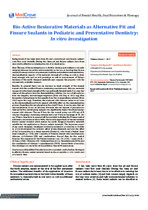| dc.contributor.author | Perchyonok, Tamara | |
| dc.contributor.author | Mulder, Riaan | |
| dc.date.accessioned | 2017-02-16T09:08:24Z | |
| dc.date.available | 2017-02-16T09:08:24Z | |
| dc.date.issued | 2017 | |
| dc.identifier.citation | Perchyonok, T. & Mulder, R. (2017). Bio-active restorative materials as alternative pit and fissure sealants in pediatric and preventative dentistry: In vitro investigation. Journal of Dental Health, Oral Disorders & Therapy, 6(1): 00184. DOI: http://dx.doi.org/10.15406/jdhodt.2017.06.00184 | en_US |
| dc.identifier.issn | 2373-4345JDHODT | |
| dc.identifier.uri | http://hdl.handle.net/10566/2535 | |
| dc.identifier.uri | http://dx.doi.org/10.15406/jdhodt.2017.06.00184 | |
| dc.description.abstract | BACKGROUND: It has been more than 40 years since the pit and fissure sealants were first used clinically. During this time, pit and fissure sealants have been shown to be effective in reducing the risk of occlusal caries.
AIM: The aim of the investigation is to further develop and evaluate a versatile designed chitosan based bio-active materials on for use as bonding free fissure sealant/fissure protectors on permanent dentition and evaluate remineralization/demineralization capacity of the materials through pH cycling, as well as shear bond strength etch and no etch prototype as well as measurement of Vickers hardness of the newly designed materials and compare the property with the commercially available standard.
RESULTS: In general there was an increase in bond strength of the enamel treated with the modified Premise containing nanodiamond: chitosan materials compared to the bond strength of the conventionally bonded teeth. It is seen that release of phosphorus into the dematerializing solution (i.e. loss of phosphorus from the samples) showed larger amplitude (from 600.2mg to 101.3 mg) than the uptake of phosphorus by the samples from the re-mineralizing solution (from 125.2 mg to 66.1 mg). Therefore, the treatment with chitosan seems to act more on the demineralization of tooth enamel with little effect on the remineralization process. Regarding the net phosphorus loss (net P loss), it can be seen that net demineralization occurs in all cases. However, the net amount of phosphorous released by the control group samples was significantly higher than those groups treated with chitosan. The net P loss for the control group was 475 mg of P, whereas the groups containing chitosan had a net P loss in the range of 30-182 mg. When a 1mm layer is assessed all the materials including the Premise control indicated a conversion of above 96%, which is the upper limit of the conventional fissure sealant material which makes the newly designed bioactive materials suitable for the application as fissure sealant materials. The important aspect of any newly designed/ developed restorative material is cytotoxicity as Grobler et. al [1] investigated the cytotoxic effect of nanodiamonds and also the effect of the incorporation in a dental material (Premise), who found a higher shear bond strength (p < 5%) after 3 months of Premise treated with nanodiamonds, chitosan, cyclodextrin (CD) and combinations thereof than for the control Premise. The sequence for the Vickers hardness was: CD (32.5) < nano (34.8) < CD Nano (38.8) < Premise (39) < Chitosan Nano (42.2). Nanodiamonds (92%) and the combination of chitosan + nanodiamonds (93%) showed little cytotoxicity. The shrinkage was lower for all the additions than for Premise alone.
CONCLUSION: All modified Flowable bio-active materials can be further developed in effective fissure sealant material based on the acceptable in vitro results and cytotoxicity data. | en_US |
| dc.language.iso | en | en_US |
| dc.publisher | MedCrave | |
| dc.rights | MedCrave is an open access which means that all content is freely available without charge to the user or his/her institution. Users are allowed to read, download, copy, distribute, print, search, or link to the full texts of the articles, or use them for any other lawful purpose, without asking prior permission from us or the author. | |
| dc.subject | Pediatric dentistry | en_US |
| dc.subject | Fissure sealants | en_US |
| dc.subject | Oral cavity | en_US |
| dc.subject | Occlusal caries | en_US |
| dc.title | Bio-active restorative materials as alternative pit and fissure sealants in pediatric and preventative dentistry: In vitro investigation | en_US |
| dc.type | Article | en_US |
| dc.privacy.showsubmitter | FALSE | |
| dc.status.ispeerreviewed | TRUE | |

